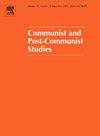How to Train Your Dragon
IF 1.3
4区 社会学
Q3 INTERNATIONAL RELATIONS
引用次数: 8
Abstract
This article examines the issue of democratic breakthroughs in highly geopoliticized, fractured regions in the post-Soviet space. While recognizing the political challenges of democratic transitions in such regions, it investigates specific conditions conducive to effective democratic openings in such regions. Using a case study method, it focuses on Armenia’s Velvet Revolution in 2018, which successfully challenged the previously-entrenched authoritarian regime in the country. This was particularly significant as it occurred in Russia’s security orbit. Armenia has been firmly wedged in Russia-centric regional organizations, in parallel to the deep bilateral ties between the two countries developed since the Soviet collapse. This article argues, first, that the efficacy of nonviolent civil disobedience campaign played a key role in ushering a peaceful democratic breakthrough. This strategy is also credited for explaining Russian restraint as the events unfolded throughout the year. Second, it also highlights the specific form of Armenia’s authoritarianism and the institutionalization of the state that it had produced. It posits an autocrat’s dilemma: greater state institutionalization to defend the “soft” authoritarian system at some point becomes a liability. This dual-track approach to the study of Armenia’s Velvet Revolution, the civil society and the state, is also used to explain Russian restraint as a factor in this case. The article concludes with a brief application of this dual-track transition model to the unyielding mass protests in Belarus, also occurring in Russia’s security orbit.如何训练你的龙
本文探讨了后苏联时代高度地缘政治化、分裂地区的民主突破问题。在认识到这些地区民主过渡的政治挑战的同时,它调查了有利于这些地区有效民主开放的具体条件。它采用案例研究的方法,重点关注2018年亚美尼亚的天鹅绒革命,该革命成功地挑战了该国先前根深蒂固的独裁政权。这尤其重要,因为它发生在俄罗斯的安全轨道上。亚美尼亚一直被牢牢地夹在以俄罗斯为中心的地区组织中,与苏联解体以来两国之间发展的深厚双边关系平行。本文认为,首先,非暴力公民抗命运动的有效性在实现和平民主突破方面发挥了关键作用。这一策略也被认为解释了俄罗斯在全年事态发展时的克制。其次,它还强调了亚美尼亚威权主义的具体形式及其所产生的国家制度化。它提出了一个独裁者的困境:在某个时候,为了捍卫“软”独裁制度而加强国家制度化成为一种负担。这种研究亚美尼亚天鹅绒革命、公民社会和国家的双轨方法也被用来解释俄罗斯的克制是本案中的一个因素。文章最后简要介绍了这种双轨过渡模式在白俄罗斯顽固的大规模抗议活动中的应用,这些抗议活动也发生在俄罗斯的安全轨道上。
本文章由计算机程序翻译,如有差异,请以英文原文为准。
求助全文
约1分钟内获得全文
求助全文
来源期刊

Communist and Post-Communist Studies
Multiple-
CiteScore
1.90
自引率
0.00%
发文量
23
期刊介绍:
Communist and Post-Communist Studies is an international journal covering all communist and post-communist states and communist movements, including both their domestic policies and their international relations. It is focused on the analysis of historical as well as current developments in the communist and post-communist world, including ideology, economy and society. It also aims to provide comparative foci on a given subject by inviting comments of a comparative character from scholars specializing in the same subject matter but in different countries.
 求助内容:
求助内容: 应助结果提醒方式:
应助结果提醒方式:


